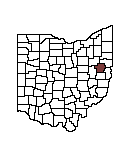County History as reported
in The Free Press Standard in 1933
Colonial Troops Passed Through Carroll County
Early Expedition Set Up First Stockade Near Bolivar
(Reprinted from issue of January 2, 1884)
In presenting the first installment of these annals last week we closed with an account of the county as it was in 1840. But owing to the difficulty attending the collection of historical material, the reader will be kind enough to bear with the writer if he is compelled to digress and not present the circumstances in regular sequence.
We now take the reader to a period ante-dating the Revolutionary war, to about the year A. D. 1750; prior to which time we have nothing but a few unverified traditions, and nothing more. Comparatively little is know of this part of Ohio until after Col. Bouquet's Expedition to the Indian towns on the Tuscarawas and Muskingum rivers, in 1764. Col. Bouquet's army of 1500 men was organized at Carlisle, Pa., arrived at Ft. Pitt September 17 and marched from thence for the Upper Muskingum, now called Tuscarawas, river, passing through Jefferson-co. north of Steubenville, entering Carroll-co near the Lee and Loudon township line, and marched between the present site of Carrollton and Dell Roy. They reached the Tuscarawas on October 15 and proceeded at once to erect a temporary fort. Having treated with the several Indian tribes along his line of march, Col. Bouquet returned to Ft. Pitt early the next spring. The principal tribes with which he treated were the Wyandots (called Hurons by the French), the Delawares, and the Shawnees (both of the Algonquin group), the Miamis, the Mingos (an offshoot from the Iroquois or a fragment of the Six Nations), the Ottowas and the Chippewas.
Fort Laurens Built
Gen. Lachlin McIntosh, commander of the Western Military Department, made an expedition in 1778 with discretionary powers, from Ft. Pitt to the Tuscarawas, with about 1000 men, following the course of Col. Bouquet through the southern part of what is now Carroll-co. Near the present town of Bolivar, in Tuscarawas-co, he built Ft. Laurens, the first fort ever built west of the Ohio river. He garrisoned it with 150 men, under command of Col. John Gibson, and then returned to Ft. Pitt. Ft. Laurens was built in 1778, and named in honor of the then President of the Continental Congress, Henry Laurens.
Disaster attended the fort from the beginning. The Indians stole their horses and drew the garrison into several ambuscades, killing 14 men at one time and 11 at another, besides capturing a number also. Eight hundred warriors appeared at one time and kept up a ____ for six weeks. Although it was regarded very desirable, for various military reasons, to have a garrisoned fort and depot of supplies at a point about equa-distant from the forts on the Ohio river and the hostile Indians on the Sandusky Plains, yet so disastrous had been the fate of Ft. Laurens, that it was abandoned in August, 1779. Fifty-seven years ago the Ohio canal was cut through it and but little remains to show where the first of Ohio's military earthworks erected by the white race, stood.
A few years ago, while men were at work grading a road-bed for the Conotton Valley railroad, south of Dell Roy, the exterior of an old brass button was found near a spring. It bore the Royal Coat of Arms (a rampant lion and unicorn), on the face and on the reverse was stamped the name of the manufacturers at Birmingham, England. Near the same spot was found a coin bearing date of 1728, one side of which was a medallion of King George, whose peruke was in the form of a queu. These are but circumstances in confirmation of the foregoing account of Colonial troops having passed through the country now known as Carroll-co.
Indian Rendezvous
The usual rendezvous for Indians was at the Mingo Bottoms -- near where Steubenville was erected -- and the several Indian towns along the headwaters of the Tuscarawas river. The Mingos and Tuscaroras doubtless chased the frightened fawn and "bruen" over the hills and dells of Carroll-co, and they may have had many an Indian battle within the present limits of this county, if still other circumstances can be taken into account. For within the past twelve months a few Carrollton boys gathered a hatfull of arrowheads in Fawcett's meadow, in Union-tp, which evinces the occurrences of something more than ordinary in that locality.
But, as there is very old authority for saying that "the heathen must perish from the face of the earth," we must leave the Red Man to follow the setting sun, and return to our own kindred. For the early days of this county's settlement witnessed nobler heroism than those of Indian atrocities and braver patriotism than the use of the tomahawk and scalping knife; as the pioneer's heroism was that of endurance and his patriotism was creative.
"Johnny Appleseed"
In the early settlement of this part
of the country there was an individual traversing the land, with far
reaching ideas of our future wants, that in modern parlance,
he might be called a "crank." His name was Jonathan Chapman. Remember
his name for it is engrafted in every orchard. He was born in Boston in
the year 1775. His whole life was devoted to the work of
planting apple seeds in remote places, and thus earned the name of
"Johnny Appleseed" -- by which name he was known in every log cabin
from the Ohio river to the Northern lakes.
The first reliable trace of our modest hero finds him in the territory of Ohio in 1801, with a horse load of apple seeds. The seeds he gathered from the cider presses of western Pennsylvania; but his canoe voyage in 1806 appears to have been the only time he used that mode of conveyance, as all his subsequent journeys were made on foot. The sake used by him was made of leather in order to withstand the rough usage to which it had to be submitted. "Johnny" would shoulder his bag of apple seeds and with bare feet penetrate some remote spot, plant a few seeds, then proceed to the next spot selected by him, until the seeds were all disposed of, and then return for another supply. The orchard on the old Ward farm, about a mile southwest6 of Carrollton, now owned by James Huston, has been pointed out as a growth from seeds planted by Johnny Appleseed.
That the pioneers of this county braved the dangers and endured the privations incident to their lot is fully attested by the footprints of their industry, as well as the dearth of crime and the machinery of the law. Courts of justice were not formed and the means of punishing the guilty were unknown for many years among this rude and uncultivated, though happy people. It is difficult to imagine to a certainty the condition of these struggling men and women, to whom we owe so much of the comfort and luxury we now enjoy. Where the railroad now brings within easy reach of the farmer his farming implements and supplies of every kind, in exchange for his products of the soil which find a ready market in his immediate neighborhood; then he was compelled to travel bad roads and along bridle paths for many miles, camping at night amid unseen dangers and even then was not able to procure very readily the more essential articles, without great trouble and expense. As late as 1885 there was not general market for the produce of the country short of New Lisbon or Steubenville, on the Ohio river, although wheat could be sold by hauling it to Zoar, Bolivar or Massillon.
First School House
Lee-tp has the honor of having
erected the first school house within the county. It was at Harlem
Springs that Prof. A. D. Lee erected his Rural Seminary, which has
since been changed to Harlem Springs college, an institution which now
rivals many of the halls of learning in the eastern states.
In the earlier days people worshipped in private houses, the preaching being done by circuit riders, some of whom preached daily and required four weeks to complete the circuit. Carrollton claims to have built the first church or "meeting house" in the county; but there is a dispute as to its exact locality. Some have located it as the one which stood in the rear of the old cemetery near the Sinclair monument; others have it as the one made of logs on the site of the present Methodist church. Thomas Rigdon preached the first sermon in Brown-tp and organized the first Sunday school in the spring of 1831.
The first newspaper published in Carrollton, then known as Centreville, was started in 1831 by Joshua D. Patton, who edited and published it under the name of the Recorder. A copy of this paper dated Centreville, Columbiana-co, Ohio, October 24, 1832, is still preserved by Melville Karn. In 1834 the Recorder was sold to Chester ∓ Johnson for $150, and they changed the name to the Free Press.
The first term of court in the county was held at the house of David J. Levy -- situated on what has since been called "Meister's Corner," the present site of Stockon's Bank. The house, built of logs, has been moved to the east end of town, and at this writing is owned and occupied by ex-Sheriff John H. Hemming.
(This newspaper article was extracted from Carroll Co. Historical Society microfilm, and submitted by Susan Mann King, NLowry@aol.com)



